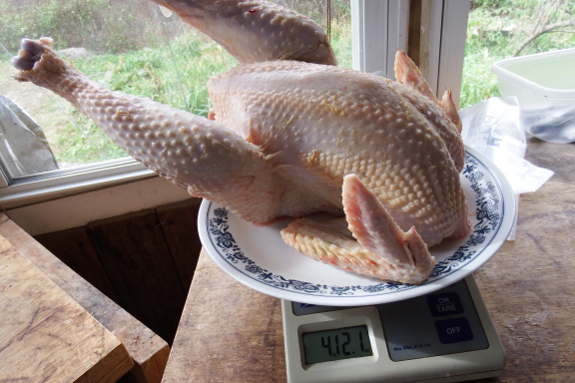
Praise for the Red Ranger

A couple of you asked for more information on Mark's first Red Ranger butchering post. In case you missed it, I commented with lots of stats here.
The only additional bit
of information is the final weight after butchering all sixteen birds.
The lightest bird was 3 pounds 13.5 ounces, the heaviest bird was 5
pounds 12.8 ounces, and the average weight was 4 pounds 13.3 ounces.
Most were so big I had to cut the legs off before packing them away in
gallon ziploc bags!
I really enjoyed working
with this breed, despite it being a hybrid, and I'm pretty sure we're
going to give them another go next year. I think we'll start a few weeks
earlier, though, so the birds aren't finishing off after the killing
frost. And we might also kill them a couple of weeks younger since I
suspect the feed-to-meat ratio
got considerably worse during their last few weeks of life. The
broilers also got a lot lazier about foraging during that period,
meaning they were packing away more bad fats and fewer good fats --- yet
another reason to kill them young.
But, all told, I now think Red Rangers are a good compromise between the fast growth and good conversion ratio of the Cornish Cross and the better foraging and survivability of the heirloom bird.
Right now, if someone asked me which broiler to raise on pasture next
year, I'd feel confident saying "Red Rangers all the way!"
Want more in-depth information? Browse through our books.
Or explore more posts by date or by subject.
About us: Anna Hess and Mark Hamilton spent over a decade living self-sufficiently in the mountains of Virginia before moving north to start over from scratch in the foothills of Ohio. They've experimented with permaculture, no-till gardening, trailersteading, home-based microbusinesses and much more, writing about their adventures in both blogs and books.
Want to be notified when new comments are posted on this page? Click on the RSS button after you add a comment to subscribe to the comment feed, or simply check the box beside "email replies to me" while writing your comment.

When we raised CX for sale and strictly followed Salatin's methods we got a feed conversion rate of 2:1. It's not hard to do if you are diligent about fresh range for the chickens, free range really lowers the feed conversion rates on any breed because it only takes a few days for the insects and "low hanging" fruit to be foraged out of existence. It's the same with grazers, they eat they high energy part of the plant the first day and then if not moved or allowed to range far and wide they are forced eat farther down the plant and at that point are getting just fodder.
The best chicken we raised for ourselves were the roosters from our pullet batches, and butchered at 20 weeks. After 12 weeks or so the meat changes and becomes more flavorful, so it's no wonder the CX are bland, they are still babies. We used to eat a lot of chicken but no more, too expensive to raise anymore, the price of feed grains are astronomical for what you get. It may be different in your area where more feed grains are actually grown.
Nita --- You're totally right. That was my final analysis of Cornish Cross --- they simply don't range well enough for my rotational pastures to work. With layers and even the Red Rangers, simply turning them into a new pasture every week and rotating back around to the first pasture in a month keeps the cream growing, but not so with Cornish Cross. Unfortunately, we don't have the type of pastures you need to do Salatin-style tractoring --- too many trees and hills.
It's pretty pricey to buy chicken feed here too. But I can no longer conceive of cooking without their broth, so we have to grow enough to make soup bases.